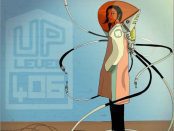[dropcap style=”font-size:100px; color:#992211;”]W[/dropcap]hen Elisabeth of Bilton became the last extinguished furnace in 1979 much of the industry that first set ablaze youthful doom metal was gone.
At this point, Black Sabbath’s music took on a whole different meaning and they became the purveyors of this sound, a title otherwise intangible to a hereafter de-industrialised region. My thoughts, therefore, lie not in deciphering Black Sabbath’s authenticity but in exploring how the mitigating circumstances of their rise to fame culminated in an unprecedented institutionalised success.
The subversive 1920s rotoscopic art of Marcel Duchamp ,a precursor to Master Of Reality’s album cover , aka “vertigo swirl”, which seemed to add the proverbial icing to an anything but sweet musical medley by Black Sabbath, reflects in my hopelessly metal-ignorant mind the inquisitive nature of the four Aston boys, their music, lyrics and unforgettable moshing spectators. Just as we, the ever-stimulated audience can gaze meditatively upon the optical illusion of the cover design, so too can our ears fall deep into Sabbath’s vociferous and lewd magnificent metal; their very own whirlpool of contradictions. This synergy of art imitating music is a rare one and allows me to focus on Black Sabbath not just as a band but the ever-changing relationship of society as a whole to its fiendish and at times, ridiculed music and its unquestionable success.
However great Black Sabbath became, the evident provocation of the wild, the erratic and almost mystic in their tormented neo-gothic music derives, in my opinion, from the social dimensions on which they depended. These range from the personal loss of long-standing guitarist Tony Iommi’s fingertips in a sheet-metal factory years before he chiselled the notorious barbed riff on their first album, to the industrialised Black Country’s furnaces, out of which raged occult images of horror and metallised beats which were to burn brightly from the 60s to the 80s. The striking illusions created by lyrics such as “under the mask you’ll see the master of insanity” pay homage to nihilism, prolong anarchism but ultimately take you full circle back to your truth.
Could the vertigo swirl on the album cover point to these furnaces, these illusions and their ability to create something other than what you see, albums which would ridicule the competition at the time? Sabbath’s music surely backs this idea. It takes on not so much political but more animalistic tones, such as in War Pigs, where language ceases to communicate and is replaced by the more musically articulate version; just noise.
I marvel at Sabbath’s prevailing values, expressed through their almost apocalyptic curses bleeding and spitting into their audience, plummeting the listener to the unknown in themselves and churning them out of the dark howl into a fetish world of leather and hope; the immense fusion of screams, snares, enucleated riffs and a violating bass exemplified in ‘Sabbath Bloody Sabbath’ is a vertigo swirl of noise, experience and consequence.
Ultimately, I believe that Black Sabbath’s music seems to neatly mesh with the Dadaist principles of anti-art and absurdity and the band have embodied their infamous ‘vertigo swirl’ album cover, so as to make Duchamp, Dadaist and original creator of roto-reliefs, very proud.
By Isabell Jacobson
[ This vignette is part of our 500 words on Black Sabbath series ]
Credit: Illustration by Derren Toussaint. 2018.























